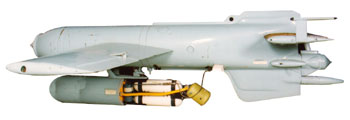Henschel HS293
| Serial No: | n/a |
| Period: | WWII |
| Reference: | 1987/0061/O |
| Museum: | Midlands |
| Location: | Hangar 1 |
| On Display: | Yes |
Development of the Henschel 293 began in May 1940; the research led by Professor Dr Herbert A Wagner. The HS293 was designed as a glider bomb based on the 500kg (1,102lb) general purpose bomb.
Simple aerofoils were fitted with solenoid driven actuators which moved the ailerons, and an electric wormscrew jack which moved the elevator.
In December 1940 the pre-production 293A-O was being tested with the addition of a rocket motor which produced 600kg (1,323lb) of thrust for 10 seconds. The rocket motor was added to quickly drive the missile to a position where the operator in the aircraft could easily observe the behaviour of the missile.
Many missiles were tested using a command wire link, however the missile was primarily produced with a radio command link. To allow multiple engagements from a squadron of launch aircraft, 18 channels were used to prevent interference between aircraft.
The HS293 became operational at Cognac, France, in the summer of 1943. On 27 August HMS Egret became the first casualty in history to be sunk by an Air-to-Surface Missile (ASM). Many vessels were subsequently sunk by the HS293, including 4 British destroyers. Flares were added to the missile to assist the operator during both day and night engagements. At least 2,300 of these missiles were fired in anger.
Attempts were made to develop television guidance for the HS293 in the D variant, however satisfactory reception at range could never be achieved.






